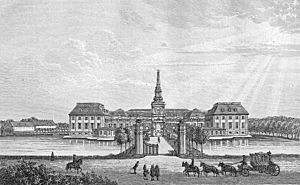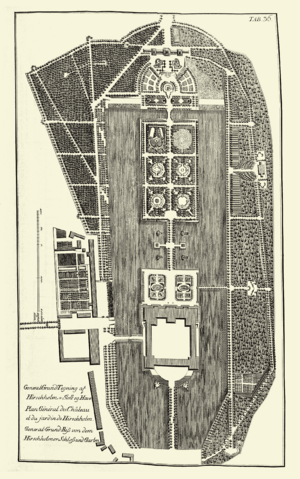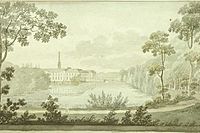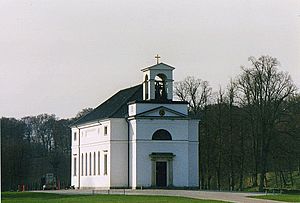Hirschholm Palace facts for kids
Quick facts for kids Hirschholm Palace |
|
|---|---|
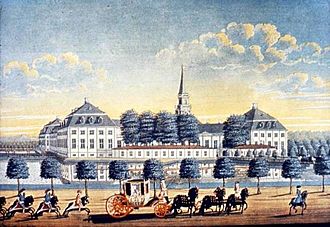 |
|
| General information | |
| Architectural style | Baroque |
| Town or city | Hørsholm |
| Country | Denmark |
| Construction started | 1733 |
| Completed | 1744 |
| Demolished | 1809-13 |
| Client | Sophia Magdalena of Denmark |
| Design and construction | |
| Architect | Lauritz de Thurah |
Hirschholm Palace, also known as Hørsholm Palace, was a grand royal palace in Hørsholm municipality, just north of Copenhagen, Denmark. It was rebuilt in the beautiful Baroque style in the 1740s. People often called it the "Versailles of the North" because it was so impressive.
The palace became well-known due to events involving Queen Caroline Mathilda in the 1770s. After these events, the palace was not used much and slowly fell apart. It was eventually taken down between 1809 and 1813.
Lauritz de Thurah designed the palace for King Christian VI and his wife, Queen Sophie Magdalene. They wanted it to be their special summer home.
Contents
History of Hirschholm Palace
Early Times at the Site
Hirschholm Palace was built on a very old site. People had used this spot since the Middle Ages, around the year 1100. Back then, it was a fort called Hørningsholm. In 1391, Queen Margrete I took over the land, making it part of the royal property.
Later, kings like Frederik II and Christian IV built a royal hunting lodge here. The land around it was huge, covering several modern-day towns. It was known as the Noble Estate of Hørsholm.
By the mid-1600s, it became a tradition for the king to give Hørsholm Palace to his queen. She would use it as her summer home. The royal family managed the estate directly, and its income went to the Queen.
Queen Louise, who was married to Frederick IV, owned the palace from 1700 to 1721. She updated it and added more farm buildings.
The Grand Baroque Palace
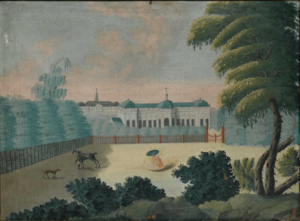
In 1730, when he became king, King Christian VI gave Hirschholm to his wife, Queen Sophie Magdalene. She decided to turn the old castle into a grand summer home for them. Before this, the buildings were quite simple and old.
The new Baroque palace, designed by Lauritz de Thurah, was finished in 1744. It was one of the most amazing buildings of its time. People called it "The Versailles of the North."
When the king passed away in 1746, Sophie Magdalene lived there as the Queen Dowager (a queen who is a widow). She made many changes to the estate, which helped lead to new farming methods in Denmark.
Thurah's drawings of the palace were later published in a book called Den Danske Vitruvius.
Queen Dowager Sophie Magdalene died in 1770. The palace then went to King Christian VII. He used it as a summer home for his family and royal court. In the summer of 1771, the royal family stayed at the palace. Queen Caroline Mathilde gave birth to her daughter, Princess Louise Augusta, there. This period is known as the "Hirschholm Summer" in Danish history.
The Palace Falls Apart
After the summer of 1771, and following some big changes in the royal court, the palace was left empty. It stayed empty until 1810. By then, the palace was in very poor condition. King Frederik VI decided to have it torn down. The materials from Hirschholm Palace were used to help rebuild Christiansborg Palace. Christiansborg Palace had been destroyed in a fire in 1794.
Hirschholm Today
In 1822-23, a small church was built on the land where the palace once stood. Architect Christian Frederik Hansen designed this church. The park around the church is on a small island in a lake. You can still see some parts of the original palace garden there.
Some of the farm buildings that Queen Louise had built in the early 1700s are still standing today. The Hørsholm Local History Museum has a special display about the palace and its royal history.
See also
- List of castles and palaces in Denmark
- List of Baroque residences


